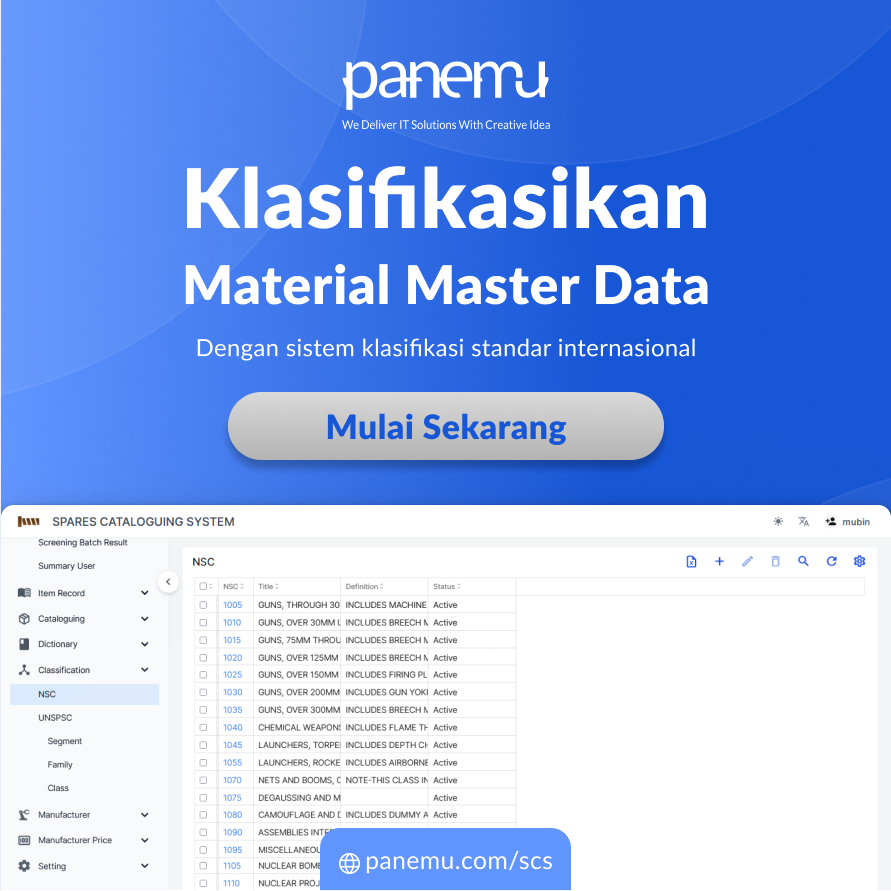How Asset Hierarchy in Material Cataloguing Empowers Companies to Set Maintenance Priorities and Optimize Budget Allocation
Why Asset Hierarchy is the Key to Modern Corporate Asset Management
Imagine the complexity of managing thousands of assets in a manufacturing plant, a power generation facility, or a chemical factory. Picture an Operations Director who must decide which machines to prioritize for maintenance, or a Finance Manager who needs to allocate budgets efficiently for repairs and spare parts replacement. Without a structured system, these critical decisions become prone to errors, waste, and potentially costly downtime.
This is precisely where the concept of Asset Hierarchy becomes indispensable. In the world of MRO (Maintenance, Repair, and Operations), Inventory, and Asset Management, an asset hierarchy serves as the foundational framework that enables organizations to group, identify, and manage assets systematically. More than just a list, an asset hierarchy is a map that guides companies in setting maintenance priorities, optimizing budget allocations, and enhancing overall operational efficiency.
This article will guide you through a comprehensive understanding of how asset hierarchy plays a pivotal role in material cataloguing, and how this structure can become a strategic tool for better decision-making at the corporate level. We will break down the concepts, functions, benefits, and real-world case studies relevant to today's industrial landscape.
What is an Asset Hierarchy?
Definition of Asset Hierarchy
Simply put, an asset hierarchy is a tiered structure for grouping assets, organized from the highest level (e.g., the entire plant or facility) down to the lowest level (e.g., individual components). This hierarchy maps the relationships between assets, from main systems and sub-systems down to the smallest parts that make up the whole.
For example, in a chemical plant, the asset hierarchy might look like:
Level 1: Plant (the entire facility)
Level 2: Main Areas (e.g., Production Area, Utilities Area)
Level 3: Systems (e.g., Pump System, Cooling System)
Level 4: Sub-systems (e.g., Pump A, Pump B)
Level 5: Components (e.g., Motor, Seal, Bearing)
Each level in this hierarchy has its own specific function and role within the overall production process.
Asset Hierarchy in Material Cataloguing
In the context of material cataloguing, the asset hierarchy serves as the main reference for grouping, identifying, and linking materials (spare parts, consumables, tools) to the assets that require them. This ensures that every material entered into the system is truly relevant to the needs of the existing assets.
A well-structured material catalogue is always based on the asset hierarchy, so that every spare part can be traced to its use down to the smallest component. This is crucial to avoid unnecessary procurement and to ensure the availability of critical spare parts.
International Standards for Asset Hierarchy
Several international standards guide the development of asset hierarchies, including:
ISO 14224: Provides guidelines for collecting and exchanging reliability and maintenance data for equipment in the process industry.
ISA-95: An international standard for the integration of enterprise and control systems, including asset hierarchy structures.
IEC 81346: A standard for the designation and structuring of industrial systems.
By referring to these standards, companies can ensure that their asset hierarchy is compatible with global asset management systems and ready for integration with IT solutions such as EAM (Enterprise Asset Management) or CMMS (Computerized Maintenance Management System).
In-Depth: Functions, Benefits, and Applications of Asset Hierarchy in Corporate Management
1. Setting Maintenance Priorities
One of the biggest challenges in asset management is determining which assets should be prioritized for maintenance, especially when resources (time, labor, budget) are limited. The asset hierarchy provides a comprehensive overview of asset relationships, enabling management to:
Identify criticality: With the asset hierarchy, companies can flag assets or components that are most critical to operations. For example, a main pump in a cooling system that, if it fails, could shut down the entire plant.
Apply risk-based maintenance: By understanding the position and role of assets in the hierarchy, risk assessments can be carried out more accurately. Assets in strategic positions within the hierarchy receive higher priority in maintenance schedules.
Facilitate root cause analysis: If a failure occurs, the asset hierarchy helps maintenance teams trace the root cause down to the lowest-level component.
Real-world example:
An oil and gas company uses its asset hierarchy to identify that 20% of its assets (at the highest and most critical subsystem levels) account for 80% of potential financial loss due to downtime. As a result, preventive maintenance schedules are focused on these assets, significantly reducing the risk of major failures.
2. Optimizing Budget Allocation
Budget allocation for maintenance and asset management is often a dilemma. Without clear data and structure, spending can balloon for less critical assets, while key assets are neglected.
With an asset hierarchy, companies can:
Track costs down to component level: Every expense for materials or maintenance can be traced to the specific asset or component within the hierarchy.
Create budgets based on criticality: Funds can be allocated more generously to assets with the greatest operational and financial impact.
Reduce waste: Irrelevant or unused materials can be identified and removed from the catalogue.
Supporting data:
According to a 2017 Aberdeen Group study, companies that consistently implement asset hierarchies are able to reduce maintenance costs by 15–20% per year, thanks to more focused and effective budget management.
3. Supporting Efficient Material Cataloguing
A material catalogue linked to the asset hierarchy allows companies to:
Ensure material relevance: Each catalogued material is directly linked to the asset or component that requires it, avoiding duplication and unnecessary procurement.
Speed up material searches: Operators and technicians can quickly find the spare parts they need based on the asset hierarchy.
Improve stock accuracy: Inventory levels can be adjusted to real needs in the field, based on asset criticality and usage frequency.
4. Enhancing Operational Efficiency and Strategic Decision-Making
The asset hierarchy provides complete visibility into the condition of assets across the company. This data is invaluable for:
Long-term investment planning: Management can plan for asset replacement or upgrades in a more structured manner.
Asset performance analysis: With structured data, performance and reliability analysis for each asset level becomes easier.
IT system integration: The asset hierarchy is the backbone for EAM, CMMS, and ERP systems that require clear, consistent data structures.
5. Ensuring Compliance with Regulations and Industry Standards
Many industries—such as oil and gas, power generation, and pharmaceuticals—require companies to have structured and auditable asset documentation. The asset hierarchy is a key requirement for compliance.
Case Study: Implementing Asset Hierarchy in the Manufacturing Industry
Background
A national-scale automotive manufacturing company faced classic problems: frequent production line downtime due to machine failures, while maintenance budgets were often spent on less strategic assets. Additionally, spare parts stockpiles frequently accumulated unused, while critical parts were often out of stock.
Solution: Building an Integrated Asset Hierarchy
The company decided to develop an asset hierarchy, from the plant level, production areas, main machine systems, down to the smallest components. Each material in the catalogue was linked to the asset that required it.
Results Achieved
30% reduction in downtime due to focused maintenance on critical machines.
18% annual maintenance cost savings thanks to more targeted budget allocation.
25% reduction in material stock as irrelevant materials were removed from the catalogue.
40% faster spare part searches leading to more efficient repairs.
Analysis
This success was achieved through disciplined and consistent asset hierarchy implementation, supported by integrated IT systems linking asset management, inventory, and procurement. Every maintenance and material procurement decision always referred to the asset hierarchy, eliminating guesswork and intuition-based decisions.
Anchoring with Everyday Examples
To make the concept of asset hierarchy easier to remember, let’s anchor it to a familiar analogy. Imagine a multi-story house. Each floor, room, and piece of furniture has its own function and role. If there’s a water leak in a second-floor bathroom, you don’t need to tear down the whole house—just focus on the affected area and component.
Similarly, in asset management, the asset hierarchy helps you identify which “room” and “furniture” are most important, so maintenance and budgets can be focused precisely where needed.
Challenges in Implementing Asset Hierarchy
Despite its many benefits, building an asset hierarchy is not without challenges. Common obstacles include:
Lack of accurate initial data: Many companies do not have complete or structured asset data.
Resistance to change: Operators and technicians accustomed to the old system may be reluctant to adapt to a new structure.
IT system integration: The asset hierarchy must be compatible with existing IT systems, such as ERP, EAM, or CMMS.
Consistency in maintenance: High discipline is required to keep the asset hierarchy updated with every asset or material change.
Solutions to these challenges include regular data cleansing, involving all stakeholders in the change process, and ensuring adequate training for all system users.
Steps to Build an Effective Asset Hierarchy
To ensure your asset hierarchy delivers real value, follow these best practice steps:
1. Identify and Inventory Assets
Conduct a thorough inventory of all assets, from the plant level down to the smallest components.
Use consistent naming standards, such as those in IEC 81346.
2. Structure the Hierarchy
Group assets by function, area, and system.
Create a clear, tiered structure: Plant > Area > System > Sub-system > Equipment > Component.
3. Link Materials to Assets
Connect each catalogue material to the asset or component that requires it.
Ensure every material has a unique code and clear description.
4. Criticality Assessment
Analyze which assets and materials are most vital to operational continuity.
5. IT System Integration
Ensure the asset hierarchy is integrated with the company’s EAM, CMMS, and Inventory Management systems.
6. Training and Socialization
Provide regular training for all system users to help them understand the importance of the asset hierarchy.
7. Regular Review and Updates
The asset hierarchy is a living document that must be updated whenever assets, systems, or materials change.
Scientific Validation of Asset Hierarchy Benefits
- According to McKinsey (2022), companies with mature asset hierarchy structures can improve maintenance efficiency by up to 25% and reduce unplanned downtime risk by 30%.
- A ReliabilityWeb (2021) study found that 70% of companies that fail in asset management implementation lack a clear asset hierarchy.
- ISO 55000 emphasizes that asset hierarchy is a core pillar in effective asset management systems.
Asset Hierarchy as the Pillar of Modern Asset Management
Asset hierarchy is not just a list or a formality. It is the foundation for managing assets effectively, efficiently, and measurably. With asset hierarchy, companies can:
Set maintenance priorities based on criticality.
Allocate budgets more precisely.
Optimize material cataloguing and spare parts procurement.
Enhance operational efficiency and strategic decision-making.
More easily meet industry standards and regulatory compliance.
For professionals in MRO, asset management, and inventory, understanding and implementing asset hierarchy is the first step toward operational excellence and sustainable business advantage.
Make Asset Hierarchy Your Strategic Investment
Let’s reflect: How far has your company developed and leveraged asset hierarchy in asset management? Are maintenance and material procurement decisions still based on intuition, or are they grounded in clear, structured data?
Now is the time to transform. By building a robust asset hierarchy, you not only boost operational efficiency but also prepare your company to face future business challenges. Make asset hierarchy a strategic investment—not just an IT project, but the main pillar in your journey toward world-class asset management.
Panemu is ready to support you in building an integrated asset hierarchy based on international best practices and tailored to Indonesia’s industrial needs. With over 20 years of experience in MRO, asset management, and IT solutions, we believe that excellent asset management is the key to a stronger, more efficient, and more profitable business.
Contact the Panemu team today, and start your journey to smarter, more structured asset management.



